The (English) Football Association celebrated its 150th anniversary – and its pioneering role as the oldest national governing body in the sport of (association) football – in 2013.
Henley Royal Regatta, which had a massive influence on the early development of rowing as an amateur sport, celebrated its 150th anniversary, in 1989. As only he could, Peter Coni, the then Chairman applied the adjective “sesquicentenary” to the celebrations.
With a light stream and strong tail wind, especially on finals day, the regatta was notable for new course and intermediate records in several events. In winning the Grand Challenge Cup, one of the two events staged at the first Henley in 1839, Hansa Dortmund became the first crew to cover the Henley course in less than six minutes.
However, for those who were in the Stewards Enclosure on Sunday July 2nd, it was the final of the Ladies Plate, the second most senior event for eights, which created the drama and the abiding memories.
As one of those witnesses, it proved very difficult to concentrate on my return to work the following day. I can confess that my productivity on that Monday morning was woeful as I felt compelled to commit my recollections to paper.
It’s interesting that the observations about the reserve of British spectators is now out-dated. Perhaps the “Dorney Roar” of London 2012 owes something to the passion that can be generated by the active rowing enthusiasts who make up the overwhelming majority of the spectators in the Stewards Enclosure. Re-reading the text on the eve of Henley 2013, it dawned on me that the man “waving the gnarled piece of wood” was the legendary Harvard coach, Harry Parker who sadly passed away on 25 June 2013, aged 77.
This is what I wrote 24 years ago.
THE DAY NOTTS COUNTY WON THE LADIES PLATE – TWICE
Jim and I extracted ourselves from the Bridge Bar half an hour before the end of the tea interval in order to ensure we had a good view of what the programme told us were the last five races of the day. Leaning over the rail of the upper deck of the floating grandstand, we chatted about the races to come and the records that had tumbled earlier.
Less than five feet away, the legendary Steward and commentator Angus Robertson was quietly practicing: it was probably “R Floryn and N Rienks of Die Leythe and Okeanos, Holland on the Bucks station and P Luzek and I Gruza of Dukla Praha, Czechoslovakia on the Berkshire station” for the final of the Double Sculls Challenge Cup was due off at 5.25. Just before tea he had finally seen-off K Broniewski of AZS-AWF Warszawa, Poland, in the final of the Diamonds to yet another round of applause, and had coped admirably with the surprise breaking of the AZS Szczecin & AZS Wroclaw 1987 Fawley record in the Prince Philip.
The Ladies Plate between Harvard, reputed to be the fastest crew in America, and Notts County Rowing Association was the first race after tea at 5.15. This was the one Jim was most interested in: apparently C Bates (10 st 11 lb), the Notts County bowman was a friend of his. Jim was telling me about some selection wrangle which was bubbling in the background as the race started.
From behind me, Mr Robertson reported the progress of the crews to the massed crowds. Notts came hurtling down the course, leading to the barrier in a record equaling 1.48, lengthening out to Fawley in a record breaking 3.01 and shattering both Harvard and their semi-final full course record with a five length verdict in 6.13.
For a crew that gave away 2st 2lb per man and maintained a rate in the 40s and high 30s for most of the course, the Notts crews still had enough breath to make an incredible din as they crossed the line!
That, we thought, was that for the Ladies Plate and we turned our attention to the Visitors which was already approaching the Barrier. (Why did the Stewards revert to five-minute intervals more normally associated with Wednesday racing for the first three finals after tea? In the third race, Floryn and Rienks in the Doubles had reached the mile signal before commentators could catch up with them.)
At some point during the remaining races, probably between races 16 and 17, a man appeared behind me, and entered into deep discussion with Messrs Robertson and colleagues. In his right hand he was waving a gnarled piece of wood 6-8 inches long and about an inch and a half thick. I remember thinking it was an odd thing to carry around the Stewards Enclosure. I was about to make a wise crack about the fact that our visitor was not wearing either a jacket or a tie but thought better of it!
The visitor departed and Mr Robertson issued an urgent instruction to his radio operator to find ‘the Chairman’. Officials were dispatched in all directions. At this point, I was all-ears but I had missed out on all the intrigue. The Chairman arrived and another sotto voce discussion took place before the Chairman left decreeing that whatever it was he had ordered had better be done ‘fast!’
The result of the Special Race for Schools had hardly been announced when Mr Robertson scurried away.
Jim and I departed for the Fawley stand and the prize giving. I told Jim what had been happening behind me: he had been engrossed in a conversation with somebody else.
When the announcement was made that the prize giving would be delayed by fifteen minutes, the Holmes instinct in me (Sherlock rather than Andy) now told me that something was definitely up.
But what? Jim and I walked around the back of the Fawley stand and saw an empty space: there was no Nottingham green between the German Grand winners and the purple blazers of UL who had vanquished Ridley in the Thames.
Then Mr Robertson made another announcement. A piece of wood had become lodged in the fin of the Harvard boat and the race Umpire, who was co-incidentally the Chairman, had ordered a re-row at 8.00 pm. The crowd waiting for prize giving audibly gasped.
The prize giving came and went, and a surprisingly large crowd waited for eight o’clock and the second final of the Ladies’ Challenge Plate.
Somehow I managed to lose Jim, so I returned to the floating grandstand. He reappeared a little later with a young lady who also appeared to know the 10 st 11 lb Notts bowman. (She wasn’t a member of Stewards, but nobody seemed to notice, or care.)
Mr Robertson was already in his place at the microphone and there was chatter about esoteric subjects such as rule 30M. The Steward recounted to an enquirer that he had seen the Harvard cox reach under the boat and pull out the offending branch as the boat had crossed the line. He was totally confident that the rules had been applied fairly. Henley was all about fair play, and justice “must be seen to be done”. I asked what would happen if they dead-heated the re-row. Without hesitation he said: “That’s easy, they turn around, go back and do it again!”.
From Jim’s friend I heard how the Notts crew had had a bevy or two to celebrate already, had showered, changed into blazers for the prize giving, and de-rigged their boat.
Margaret Marshall, well-known Notts County ‘groupie’ came upstairs to the floating stand as well. She couldn’t keep still for nerves. It was one of those incredibly tense sporting moments. Nobody was certain whether the lightweights could pull off a second victory and the fairly stiff tail wind that had helped them down the course the first time had virtually disappeared.
Eight o’clock eventually arrived and the race started. Notts again left the stake boat at a heart-stopping rate and Mr Robertson announced that the Barrier record they had equaled earlier had now been reduced to 1.47. Fawley was reached in 3.01, the same time as in the first final and as the crews, still overlapping, passed the mile signal the enclosure opened its collective throat.
The British have often been accused of being too reserved and not getting behind its sportsmen and women. I am coming to the conclusion that this is not an accusation that can be levelled at the Stewards’ Enclosure. I also suspect that the nine Australians who went down by one foot to Leander in the 1988 Grand Final would agree. Harvard are probably revising their opinions too. A friend who had been standing on the river bank said that he did hear a man shout for Harvard, “but only once.”
Coming past the progress board, Harvard were still too close for the comfort of those on the bank, but at least a couple of the Notts oarsmen seemed to be unconcerned as they started punching the air.
After taking a couple of seconds to compose himself, a very relieved-looking Angus Robertson allowed himself a smile before announcing the result of the Ladies Challenge Plate: Notts County had won by two-thirds of a length in yet another new record time of 6.11.
Hundreds of spectators waited to applaud Notts as they completed a quick lap of honour past the stands and a sizeable crowd gathered to see the crew come into the landing stage to be congratulated first by Chairman Coni handing out medals and then by the Harvard crew who almost managed to capsize the pontoon. The applause only stopped when the boat was in the boat-tent.
This is the stuff of which legends are made and like all legends some aspects will be embellished in the retelling. In years to come it may be told that the Notts crew drank the Bridge Bar dry between the two races, or that the Harvard crew had one of the course booms lodged in its fin. Whatever the myths of the future, the truth on the first Sunday in July, 1989 was that Nottinghamshire County Rowing Association ‘A’ crew gave away over two stone per man and still beat the ‘fastest crew in America’ twice in a period of 2 hours 51 minutes and 11 seconds, setting record times on both occasions.
Driving home, my thoughts returned to the final of the Grand. The achievement of Hansa Dortmund in becoming the first crew to race down the Henley track in less than six minutes would have been the abiding memory of any normal Henley Finals Day. However, Finals Day of Henley’s 150th birthday regatta was far from normal.
Tom Kay, the three-man in the Notts County crew, posted his own recollections of the two finals in June 2017.
Sports photographer Peter Spurrier has a gallery of images from the 1989 regatta – including both Ladies Plate finals – which also features many of the individuals and crews mentioned in the post.



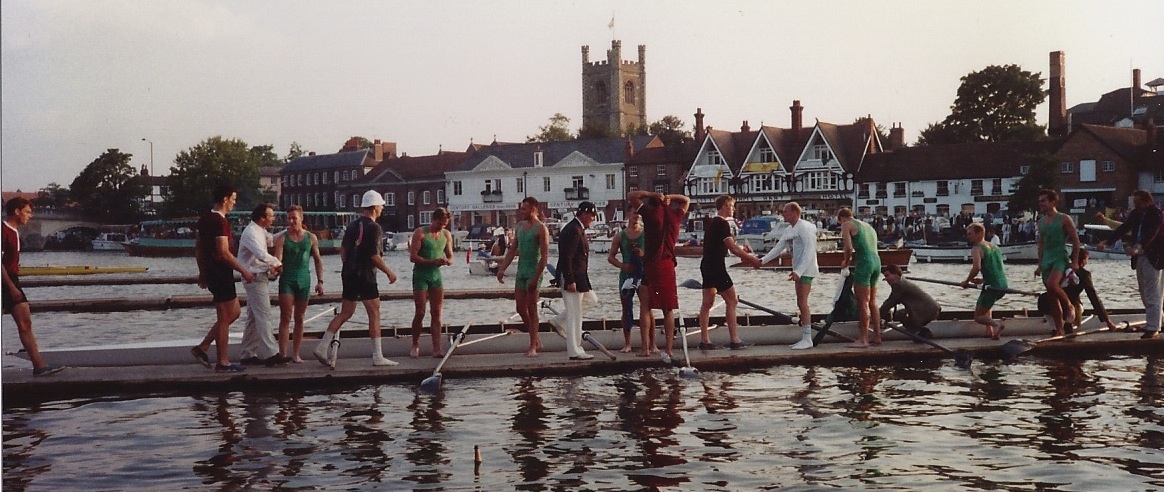
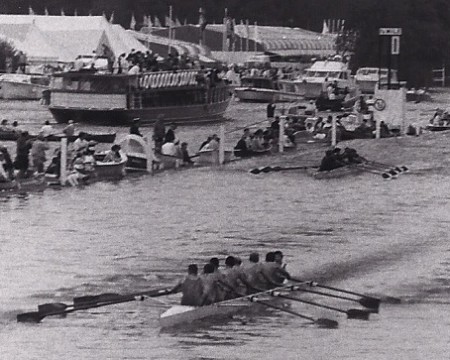
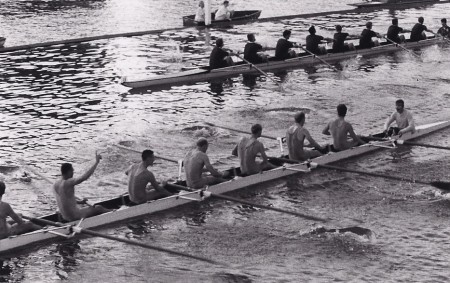
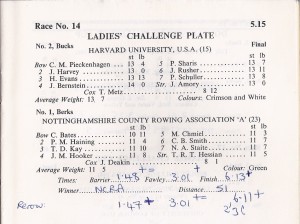
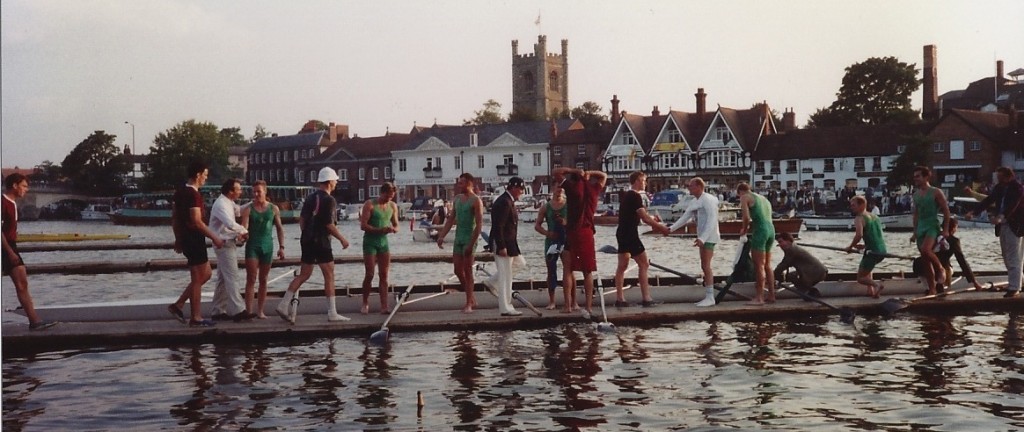
One thought on “Sporting sesquicentenaries”
I was a cox for Temple University (U.S.A.) at Henley in 1989. The Ladies Final was one the greatest race (s) I have ever seen. Loved your commentary and can hear the call over the loudspeaker as I read it. I desperately want a high-quality photo of the race for my home — ideally with both crews in frame. I checked SportsGraphics and they only have single-crew photos. Any ideas where I might be able to find/purchase?